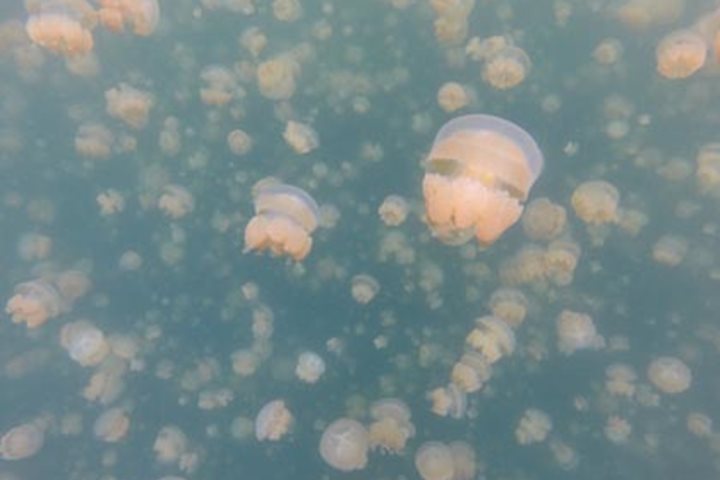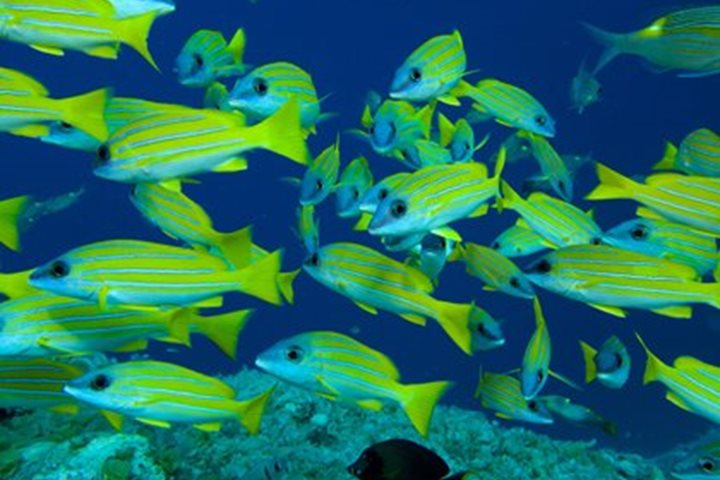Within moments of arrival on remote Kuiywawa (Kuyawa) Island we were welcomed like long lost friends. The village broke out into song while the children rushed in with handmade flower leis. Even the dogs wagged their tails in delight at the sight of all the new faces. Before the sing-sing began we were each escorted to royal thrones (desks & chairs borrowed from the only school) under the shade of the sprawling Alexandrian Laurel Trees (Callophylum innophyllum). As the singers and dancers lined up for their performance, local children climbed onto the tallest limbs for a better view of elaborately decorated relatives. The sound of native drums was woven into strumming guitars, and the harmonious voices of children. As the dancers swung from side to side their multi-colored grass skirts seemed to take on rhythm of their own. The smiles started with the children and quickly spread through the onlookers as we all enjoyed the spectacle of painted faces and beautiful music.
Only the lure of crystal clear water and sparkling fish could lure us away from the relaxed hospitality of our new friends. Within meters of the beach, the sea grass gave way to a lush garden filled with sun loving colonies of table-top and staghorn corals. Darting between the matrix of branches were black & white striped Humbug Dascylus and iridescent Blue Devil Damselfish. A lazy White Tipped Reef Shark eased over the reef on urgent business that swept him out view and into the depths beyond the reef. A careful look into the pristine reef revealed a hidden treasure, the Long Nose File Fish. Found exclusively on healthy reefs, these coral specialists maneuver themselves gracefully through the branches with subtle movements of fins on their bellies and backs. Convinced that we’d discovered Eden, we returned to the National Geographic Orion content with a morning of exploration and adventure.
Though lunch was on our minds, we paused for yet another magical moment. While we’d been awed by the spectacle of elaborately dressed natives, the locals had paddled out to our ship in dug-out canoes with woven sails. Unbeknownst to us, the ship and crew had created its own spectacle and enticed the curiosity of men, women, children, and the elders. Peering through portholes, the televisions seemed to draw the greatest crowd and will most certainly be the gossip around the evening campfire.
After a buffet lunch in the outdoor café, we slipped anchor expecting a gentle cruise through the Solomon Sea. The afternoon schedule included a photography clinic, as well as a Coral Biology lecture delivered by our undersea specialist, Mike Greenfelder. Our plans quickly unraveled when the call came over the intercom, “dolphins off the Port Bow!” We rushed to multiple decks to catch a glimpse of a raucous pod of Spinner Dolphins. Splashing, spinning, racing dolphins moved in all directions. Accompanied by flocks of noddies and terns, we’d clearly sailed into a feeding frenzy all centered around dense schools of bait fish. Even at a distance we were able to distinguish this acrobatic species of Cetaceans. The unique habit of spinning out of the water in vertical leaps of joy is found in this pan-tropical species alone.
Adding to the mystery, a procession of enormous Cannon-Ball Jellyfish passed on both sides of the National Geographic Orion. Each giant Medusa exceeded the size of a human head and pulsed to a steady beat. These super-sized Cnidarians are home to an entourage of juvenile jacks. As is the case with Clownfish, the tiny jacks hide amongst the tentacles of their stinging host, safe and comfortable in knowing that they won’t be stung, protected by sting-inhibiting chemical coats.
We returned to the lounge for discussions and lectures with each of us occasionally glancing through the windows and wondering… what will Papua New Guinea deliver next?







